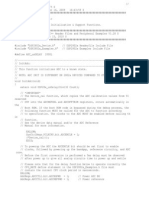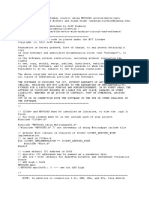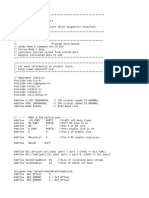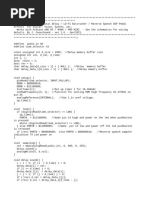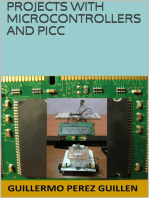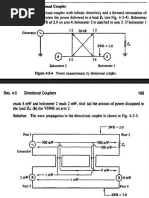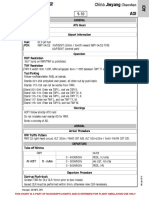PR Controller
PR Controller
Uploaded by
Ankit Chawla LCO17570Copyright:
Available Formats
PR Controller
PR Controller
Uploaded by
Ankit Chawla LCO17570Original Title
Copyright
Available Formats
Share this document
Did you find this document useful?
Is this content inappropriate?
Copyright:
Available Formats
PR Controller
PR Controller
Uploaded by
Ankit Chawla LCO17570Copyright:
Available Formats
// TI File $Revision: /main/1 $
// Checkin $Date: May 27, 2009 13:16:04 $
//###########################################################################
//
// FILE: Example_2823xLedBlink.c
//
// TITLE: DSP2823x eZdsp LED Blink Getting Started Program.
//
// ASSUMPTIONS:
//
// This program requires the DSP2823x header files.
//
//
// As supplied, this project is configured for "boot to SARAM"
// operation. The 2823x Boot Mode table is shown below.
// For information on configuring the boot mode of an eZdsp,
// please refer to the documentation included with the eZdsp,
//
// $Boot_Table:
//
// GPIO87 GPIO86 GPIO85 GPIO84
// XA15 XA14 XA13 XA12
// PU PU PU PU
// ==========================================
// 1 1 1 1 Jump to Flash
// 1 1 1 0 SCI-A boot
// 1 1 0 1 SPI-A boot
// 1 1 0 0 I2C-A boot
// 1 0 1 1 eCAN-A boot
// 1 0 1 0 McBSP-A boot
// 1 0 0 1 Jump to XINTF x16
// 1 0 0 0 Jump to XINTF x32
// 0 1 1 1 Jump to OTP
// 0 1 1 0 Parallel GPIO I/O boot
// 0 1 0 1 Parallel XINTF boot
// 0 1 0 0 Jump to SARAM <- "boot to
SARAM"
// 0 0 1 1 Branch to check boot mode
// 0 0 1 0 Boot to flash, bypass ADC cal
// 0 0 0 1 Boot to SARAM, bypass ADC cal
// 0 0 0 0 Boot to SCI-A, bypass ADC cal
// Boot_Table_End$
//
// DESCRIPTION:
//
// This example configures CPU Timer0 for a 500 msec period, and toggles the
GPIO32
// LED on the 2823x eZdsp once per interrupt. For testing purposes, this example
// also increments a counter each time the timer asserts an interrupt.
//
// Watch Variables:
// CpuTimer0.InterruptCount
//
// Monitor the GPIO32 LED blink on (for 500 msec) and off (for 500 msec) on
the 2823x eZdsp.
//
//###########################################################################
// $TI Release: 2833x/2823x Header Files V1.32 $
// $Release Date: June 28, 2010 $
//###########################################################################
#include "DSP28x_Project.h"
#include "math.h"
// Device Headerfile and Examples Include File
#if (CPU_FRQ_150MHZ) // Default - 150 MHz SYSCLKOUT
#define ADC_MODCLK 0x3 // HSPCLK = SYSCLKOUT/2*ADC_MODCLK2 = 150/(2*3) = 25.0
MHz
#endif
#if (CPU_FRQ_100MHZ)
#define ADC_MODCLK 0x2 // HSPCLK = SYSCLKOUT/2*ADC_MODCLK2 = 100/(2*2) = 25.0
MHz
#endif
#define ADC_CKPS 0x0 // ADC module clock = HSPCLK/1 = 25.5MHz/(1) = 25.0
MHz
#define ADC_SHCLK 0x1 // S/H width in ADC module periods = 2
ADC cycle
int a=4;
int b;
float ir = 0.0;
float del_ts = 0.00001492,Ws= 314.16,Wc=50.;
float ir_diffi, ir_diffi_pre=0., ir_diffi_pre1=0.;
float
Kp=.3,Ki=600.,Kr=50.,pr_r,Ir_r,prlimit1=.7,Ir_r_limit=3,iout_error_resonance_limit=
3,iout_error_resonance1_limit=1,iout_error_resonance2_limit=1,Error_r;
float iout_error_resonance=0., iout_error_resonance_pre=0.,
iout_error_resonance_pre1=0.,iout_error_resonance1=0.,
iout_error_resonance1_pre=0.,
iout_error_resonance1_pre1=0.,iout_error_resonance2=0.,
iout_error_resonance2_pre=0., iout_error_resonance2_pre1=0.;
float
a10,b01,b10,a1,a2,b0,b1,b2,c10,x=0.,a101,b011,b101,a11,a21,b00,b11,b21,c101,y=0.,a1
02,b012,b102,a12,a22,b000,b12,b22,c102,z=0.;
// Prototype statements for functions found within this file.
__interrupt void adca1_isr(void);
void main(void)
{
// Step 1. Initialize System Control:
// PLL, WatchDog, enable Peripheral Clocks
// This example function is found in the DSP2833x_SysCtrl.c file.
InitSysCtrl();
EALLOW;
SysCtrlRegs.HISPCP.all = ADC_MODCLK; // The system peripheral clock is divided
by 6 and the general ADC is divided by 6
// This is because the ADC can only be configured with a frequency of 25MHz.
// So the fastest conversion time is 80ns
EDIS;
// Step 2. Initalize GPIO:
// This example function is found in the DSP2833x_Gpio.c file and
// illustrates how to set the GPIO to it's default state.
// InitGpio(); // Skipped for this example
// Step 3. Clear all interrupts and initialize PIE vector table:
// Disable CPU interrupts
DINT;
// Initialize the PIE control registers to their default state.
// The default state is all PIE interrupts disabled and flags
// are cleared.
// This function is found in the DSP2833x_PieCtrl.c file.
InitPieCtrl();
// Disable CPU interrupts and clear all CPU interrupt flags:
IER = 0x0000;
IFR = 0x0000;
// Initialize the PIE vector table with pointers to the shell Interrupt
// Service Routines (ISR).
// This will populate the entire table, even if the interrupt
// is not used in this example. This is useful for debug purposes.
// The shell ISR routines are found in DSP2833x_DefaultIsr.c.
// This function is found in DSP2833x_PieVect.c.
InitPieVectTable();
InitAdc();
EALLOW;
PieVectTable.TINT0 = &adca1_isr; // Assign ADC ISR into pie vector table
PieCtrlRegs.PIEIER1.bit.INTx1 = 1; // Enable that interrupt
IER = 0x0001;
IER |= M_INT1;
EDIS; EINT; ERTM;
AdcRegs.ADCTRL1.bit.ACQ_PS = ADC_SHCLK; // Sequential mode: Sample rate =
1/[(2+ACQ_PS)*ADC clock in ns]
// = 1/(3*40ns) =8.3MHz (for 150
MHz SYSCLKOUT)
// = 1/(3*80ns) =4.17MHz (for 100
MHz SYSCLKOUT)
// If Simultaneous mode enabled: Sample rate =
1/[(3+ACQ_PS)*ADC clock in ns]
AdcRegs.ADCTRL3.bit.ADCCLKPS = ADC_CKPS;
AdcRegs.ADCCHSELSEQ1.bit.CONV00 = 0x0;
AdcRegs.ADCTRL1.bit.CONT_RUN = 0; // Setup continuous run
AdcRegs.ADCMAXCONV.bit.MAX_CONV1 = 1; // convert and store in 8 results
registers
AdcRegs.ADCTRL2.bit.SOC_SEQ1 = 0x1;
// Interrupts that are used in this example are re-mapped to
// Step 4. Initialize the Device Peripheral. This function can be
// found in DSP2833x_CpuTimers.c
InitCpuTimers(); // For this example, only initialize the Cpu Timers
#if (CPU_FRQ_150MHZ)
// Configure CPU-Timer 0 to interrupt every 500 milliseconds:
// 150MHz CPU Freq, 50 millisecond Period (in uSeconds)
ConfigCpuTimer(&CpuTimer0, 150, 500000);
#endif
#if (CPU_FRQ_100MHZ)
// Configure CPU-Timer 0 to interrupt every 500 milliseconds:
// 100MHz CPU Freq, 50 millisecond Period (in uSeconds)
ConfigCpuTimer(&CpuTimer0, 100, 500000);
#endif
// To ensure precise timing, use write-only instructions to write to the entire
register. Therefore, if any
// of the configuration bits are changed in ConfigCpuTimer and InitCpuTimers (in
DSP2833x_CpuTimers.h), the
// below settings must also be updated.
CpuTimer0Regs.TCR.all = 0x4001; // Use write-only instruction to set TSS bit = 0
// Step 5. User specific code, enable interrupts:
// Configure GPIO32 as a GPIO output pin
EALLOW;
GpioCtrlRegs.GPBMUX1.bit.GPIO32 = 0;
GpioCtrlRegs.GPBDIR.bit.GPIO32 = 1;
EDIS;
// Enable CPU INT1 which is connected to CPU-Timer 0:
//IER |= M_INT1;
// Enable TINT0 in the PIE: Group 1 interrupt 7
PieCtrlRegs.PIEIER1.bit.INTx7 = 1;
// Enable global Interrupts and higher priority real-time debug events:
EINT; // Enable Global interrupt INTM
ERTM; // Enable Global realtime interrupt DBGM
// Step 6. IDLE loop. Just sit and loop forever (optional):
GpioDataRegs.GPBDAT.bit.GPIO32 =0;
while(1)
{
a=a+1;
if(a>=100)
{ a=0; }
}
}
__interrupt void adca1_isr(void)
{
//GpioDataRegs.GPCDAT.bit.GPIO76 =1;
// PI Controller
pr_r=ir_diffi*Kp;
if(pr_r>prlimit1)pr_r=prlimit1;
if(pr_r<-prlimit1)pr_r=-prlimit1;
Ir_r = Ir_r+Ki*ir_diffi*del_ts;
if (Ir_r>= Ir_r_limit) Ir_r=Ir_r_limit;
if (Ir_r<=-Ir_r_limit) Ir_r=-Ir_r_limit;
// 3rd harmonic resonance controller
x=sin(3*Ws*del_ts)*(Wc/2);
a10= x/Wc;
b10=2*3*Ws*cos(3*Ws*del_ts);
c10=(3*Ws-x);
b01=(3*Ws+x);
a1=b10/b01;
a2=c10/b01;
b0=Kp+Kr*(a10/b01);
b1=b10/b01;
b2=Kp*(c10/b01)-Kr*(a10/b01);
iout_error_resonance=b0*ir_diffi+b1*ir_diffi_pre+b2*ir_diffi_pre1+a1*iout_error_res
onance_pre-a2*iout_error_resonance_pre1;
iout_error_resonance_pre1= iout_error_resonance_pre;
iout_error_resonance_pre= iout_error_resonance;
ir_diffi_pre1= ir_diffi_pre;
ir_diffi_pre= ir_diffi;
if (iout_error_resonance>= iout_error_resonance_limit)
iout_error_resonance= iout_error_resonance_limit;
if (iout_error_resonance<=-iout_error_resonance_limit)
iout_error_resonance=-iout_error_resonance_limit;
// 5th harmonic resonance controller
y=sin(5*Ws*del_ts)*(Wc/2);
a101= y/Wc;
b101=2*5*Ws*cos(5*Ws*del_ts);
c101=(5*Ws-y);
b011=(5*Ws+y);
a11=b101/b011;
a21=c101/b011;
b00=Kp+Kr*(a101/b011);
b11=b101/b011;
b21=Kp*(c101/b011)-Kr*(a101/b011);
iout_error_resonance1=b0*ir_diffi+b1*ir_diffi_pre+b2*ir_diffi_pre1+a1*iout_error_re
sonance1_pre-a2*iout_error_resonance1_pre1;
iout_error_resonance1_pre1= iout_error_resonance1_pre;
iout_error_resonance1_pre= iout_error_resonance1;
ir_diffi_pre1= ir_diffi_pre;
ir_diffi_pre= ir_diffi;
if (iout_error_resonance1>=
iout_error_resonance1_limit) iout_error_resonance1= iout_error_resonance1_limit;
if (iout_error_resonance1<=-iout_error_resonance1_limit)
iout_error_resonance1=-iout_error_resonance1_limit;
// 7th harmonic resonance controller
z=sin(7*Ws*del_ts)*(Wc/2);
a102= z/Wc;
b102=2*7*Ws*cos(7*Ws*del_ts);
c102=(7*Ws-z);
b012=(7*Ws+z);
a12=b102/b012;
a22=c102/b012;
b000=Kp+Kr*(a102/b012);
b12=b102/b012;
b22=Kp*(c102/b012)-Kr*(a102/b012);
iout_error_resonance2=b0*ir_diffi+b1*ir_diffi_pre+b2*ir_diffi_pre1+a1*iout_error_re
sonance2_pre-a2*iout_error_resonance2_pre1;
iout_error_resonance2_pre1=
iout_error_resonance2_pre;
iout_error_resonance2_pre=
iout_error_resonance2;
ir_diffi_pre1= ir_diffi_pre;
ir_diffi_pre= ir_diffi;
if (iout_error_resonance2>=
iout_error_resonance2_limit) iout_error_resonance2= iout_error_resonance2_limit;
if (iout_error_resonance2<=-
iout_error_resonance2_limit) iout_error_resonance2=-iout_error_resonance2_limit;
Error_r= pr_r+Ir_r+iout_error_resonance+
iout_error_resonance1+iout_error_resonance2 ;
ir=(AdcRegs.ADCRESULT1>>4);
b=b+1;
if(b>100)
b=0;
// Import and offset. 2080 was for 20khz board. 2067 for 10 kHz board.
//Scale to real world volts?
AdcRegs.ADCTRL2.bit.RST_SEQ1 = 1; // Reset SEQ1
AdcRegs.ADCST.bit.INT_SEQ1_CLR = 1; // Clear INT SEQ1 bit
PieCtrlRegs.PIEACK.all = PIEACK_GROUP1; // Acknowledge
interrupt to PIE
return;
}
//===========================================================================
// No more.
//==========================================================================
You might also like
- 10 John Curtis The Curtis Muir Wood FormulaeDocument2 pages10 John Curtis The Curtis Muir Wood Formulaemalcolmpo100% (1)
- Excel Time Management TodoDocument2 pagesExcel Time Management TodoAlberto Marin Calderon100% (1)
- MassMin 2012 - Mudrush Risk EvaluationDocument10 pagesMassMin 2012 - Mudrush Risk EvaluationÁALNo ratings yet
- H 1Document7 pagesH 1nilton_9365611No ratings yet
- Griet DSP ProgramsDocument14 pagesGriet DSP ProgramsJaipaul CheernamNo ratings yet
- E:/#0-2S2017/#1-TEC - SELDI/SAP-02 - Projeto Forno MCU/SELDI - SAP-02 MCU - FW/Forno - DSET-SAP01 - 137-V1.X/forno.hDocument7 pagesE:/#0-2S2017/#1-TEC - SELDI/SAP-02 - Projeto Forno MCU/SELDI - SAP-02 MCU - FW/Forno - DSET-SAP01 - 137-V1.X/forno.hVinícius Lopes Sampaio100% (1)
- Analog ShieldDocument16 pagesAnalog ShieldTrung Manh HuynhNo ratings yet
- Lab0 CDocument5 pagesLab0 CJorge Cruz Mancilla100% (1)
- Keyboard - C: Programa en C USB PIC18FDocument11 pagesKeyboard - C: Programa en C USB PIC18FLuis GonzalesNo ratings yet
- PID Position Control Dspic 30f2020Document4 pagesPID Position Control Dspic 30f2020FREEDOMHOUSE100% (3)
- PIC C Command SummaryDocument14 pagesPIC C Command SummaryEdmond LamNo ratings yet
- SodaPDF-converted-Si5351 RXTX VFO V3Document12 pagesSodaPDF-converted-Si5351 RXTX VFO V3LU8DIW Roberto MartinezNo ratings yet
- Avg AdcDocument5 pagesAvg AdcShreeharsha KolthayaNo ratings yet
- Homework 2.: Thiết kế hệ thống nhúng nâng caoDocument8 pagesHomework 2.: Thiết kế hệ thống nhúng nâng caoTRƯỜNG NGUYỄN XUÂNNo ratings yet
- Development Board For Stm8S003F3: by Nitin Chand M S (2018H1400171P), Rohith Krishnan P (2018H1400180P)Document13 pagesDevelopment Board For Stm8S003F3: by Nitin Chand M S (2018H1400171P), Rohith Krishnan P (2018H1400180P)Thông NguyễnNo ratings yet
- 2 Axis Gimbal Brushless With l298nDocument9 pages2 Axis Gimbal Brushless With l298nMano OhanianNo ratings yet
- VXL CodeDocument34 pagesVXL Codethuongtran20199No ratings yet
- EMG EKG Code For ARDUINO SHIELDDocument4 pagesEMG EKG Code For ARDUINO SHIELDbeniamin Alexandru100% (1)
- Antenna AnalyzerDocument19 pagesAntenna Analyzermarista NurdianaNo ratings yet
- Display "Hello World"message Using Internal UARTDocument16 pagesDisplay "Hello World"message Using Internal UARTAkshathaNo ratings yet
- Timer/Counter: Timer 1 Below Are The Steps For Configuring and Using The Timer1 For Delay GenerationDocument9 pagesTimer/Counter: Timer 1 Below Are The Steps For Configuring and Using The Timer1 For Delay Generationvreddykumarreddy1No ratings yet
- EXP NO.6 Removed RemovedDocument9 pagesEXP NO.6 Removed RemovedOM SARDESAI225286No ratings yet
- Balancebot CodeDocument8 pagesBalancebot CodeSam Fisher LambertNo ratings yet
- CCS ExampleDocument28 pagesCCS Exampletuane07100% (3)
- New Microsoft Word DocumentDocument22 pagesNew Microsoft Word DocumentUsama FaisalNo ratings yet
- Programa SPI MestreDocument5 pagesPrograma SPI MestreAlan Robson100% (1)
- Question No. 2 How Snmpv3 Enhances Security Compared To Snmpv2? Question No. 3 A) Define Rmon B) What Are The Benefits of Rmon ?Document32 pagesQuestion No. 2 How Snmpv3 Enhances Security Compared To Snmpv2? Question No. 3 A) Define Rmon B) What Are The Benefits of Rmon ?shravaniNo ratings yet
- CODEAVRMAUDocument13 pagesCODEAVRMAUn21dcvt066No ratings yet
- Bài tập CCSDocument15 pagesBài tập CCSBảo Siêu GấuNo ratings yet
- C51 ADC Program ExamplesDocument22 pagesC51 ADC Program ExamplesplcmanaNo ratings yet
- BAseDocument5 pagesBAseJhon PerezNo ratings yet
- MSP 430 G 2553Document24 pagesMSP 430 G 2553Steevens GarridoNo ratings yet
- PIDDocument4 pagesPIDIgnacioMartíNo ratings yet
- past paper 2020Document4 pagespast paper 2020mb7527865No ratings yet
- Buradan CodeDocument20 pagesBuradan CodeHuy TuongNo ratings yet
- PWM CDocument2 pagesPWM CMore FunNo ratings yet
- Arduino MPPT V3Document16 pagesArduino MPPT V3Isabella Sanchez0% (1)
- Çalışıyor GibiDocument11 pagesÇalışıyor GibiAli Arda YıldızNo ratings yet
- Flight ControllerDocument30 pagesFlight ControllerUsama FaisalNo ratings yet
- Assignment 1 ReportDocument19 pagesAssignment 1 ReportJyiou YimushiNo ratings yet
- Ardu5 para S4ADocument6 pagesArdu5 para S4AEDWARD ENRIQUE ROJAS BARBOSANo ratings yet
- AppendicesDocument5 pagesAppendicesRyan Ceasar MianoNo ratings yet
- CodeDocument5 pagesCodeJerry LeeNo ratings yet
- Code CounterDocument4 pagesCode CounterMbah TakokakNo ratings yet
- 1wire2wayz BidirectionalDocument12 pages1wire2wayz Bidirectionalmitchellreid62No ratings yet
- P12 AdcDocument2 pagesP12 AdcAnisha MaiyaNo ratings yet
- StopWatch CDocument6 pagesStopWatch CInderJeet Gehlot100% (1)
- PidDocument5 pagesPidArif Nugroho100% (1)
- DECODING HT6P20 WITH Attachinterrupt Arduino Forum PDFDocument6 pagesDECODING HT6P20 WITH Attachinterrupt Arduino Forum PDFbetodias30No ratings yet
- Pic DimmerDocument17 pagesPic DimmerStanislaw Martins RodriguesNo ratings yet
- 8Bit Digital Delay sketch (1)Document3 pages8Bit Digital Delay sketch (1)euzelioNo ratings yet
- PC 5Document8 pagesPC 5Miguel RodasNo ratings yet
- EkrannDocument6 pagesEkrannBubbleNo ratings yet
- Kamera_probaDocument6 pagesKamera_probaLuka JokićNo ratings yet
- Adcpic CodeDocument8 pagesAdcpic CodeRida Batool100% (1)
- Spi Protocol Verilog Code ExplanationDocument15 pagesSpi Protocol Verilog Code Explanationgokul pNo ratings yet
- PID Control MAX6675 Thermocouple Arduino Schematic With Rotary EncoderDocument13 pagesPID Control MAX6675 Thermocouple Arduino Schematic With Rotary EncoderStewin Perez100% (1)
- Small DC Motor Control by PWM Method Using Atmega8Document4 pagesSmall DC Motor Control by PWM Method Using Atmega8Emin KültürelNo ratings yet
- Verilog Imp...Document105 pagesVerilog Imp...Arun JyothiNo ratings yet
- Medidor Motor ESP32.InoDocument5 pagesMedidor Motor ESP32.InoBrinethNo ratings yet
- Projects With Microcontrollers And PICCFrom EverandProjects With Microcontrollers And PICCRating: 5 out of 5 stars5/5 (1)
- CISCO PACKET TRACER LABS: Best practice of configuring or troubleshooting NetworkFrom EverandCISCO PACKET TRACER LABS: Best practice of configuring or troubleshooting NetworkNo ratings yet
- Takeuchi Tb108 Operators ManualDocument10 pagesTakeuchi Tb108 Operators Manualcleveland100% (66)
- Zinc Alloy Thermo-Diffusion Coatings (TDC) On Steel Fasteners, Hardware, and Other ProductsDocument5 pagesZinc Alloy Thermo-Diffusion Coatings (TDC) On Steel Fasteners, Hardware, and Other ProductsSofia Yuli100% (1)
- Brochure BellaVista AlmondDocument1 pageBrochure BellaVista AlmondJaredSeeryNo ratings yet
- Asme PTC 1 PDFDocument26 pagesAsme PTC 1 PDFpiziyuNo ratings yet
- Introduction To WEKA: 2. Weka: Download and InstallationDocument14 pagesIntroduction To WEKA: 2. Weka: Download and InstallationncetcsedeptNo ratings yet
- SOAL Latihan UN P2Document13 pagesSOAL Latihan UN P2Khairun NisaNo ratings yet
- Sinha VeenaDocument4 pagesSinha VeenaK.SUBRAMANINo ratings yet
- (Sephirotic) Kizumonogatari I Tekketsu-Hen (BD 1280x544 PHi444 DTS MA 5.1) (4929D3E2)Document3 pages(Sephirotic) Kizumonogatari I Tekketsu-Hen (BD 1280x544 PHi444 DTS MA 5.1) (4929D3E2)Anonymous 4q1mOk3lNo ratings yet
- Imp Numericals (In Order)Document15 pagesImp Numericals (In Order)Subodh KumarNo ratings yet
- PDF Isuzu Flash Code DLDocument3 pagesPDF Isuzu Flash Code DLJose herreraNo ratings yet
- Mobile IP: A Complete Solution For Emerging CommunicationsDocument3 pagesMobile IP: A Complete Solution For Emerging CommunicationsmonumunduriNo ratings yet
- ABB - Centre Break Isolator - ManualDocument8 pagesABB - Centre Break Isolator - Manualprathaban723100% (1)
- The Properties of Nanofiber Membranes Made of Aloe Vera Gel Combined With Polyvinyl AlcoholDocument9 pagesThe Properties of Nanofiber Membranes Made of Aloe Vera Gel Combined With Polyvinyl AlcoholziziNo ratings yet
- Protection Basics and TerminologyDocument33 pagesProtection Basics and TerminologyMuhammad AbuzarNo ratings yet
- W Brochure W240CR-W380CRi 1118 V1 EN PDFDocument60 pagesW Brochure W240CR-W380CRi 1118 V1 EN PDFkrishan gopal tyagiNo ratings yet
- Manufacturing SystemsDocument14 pagesManufacturing SystemsPradeep Kumar MehtaNo ratings yet
- Aceites Refrigerantes PDFDocument5 pagesAceites Refrigerantes PDFLankaster Flórez ChNo ratings yet
- VdwsmonjhgdjDocument2 pagesVdwsmonjhgdjHantuNo ratings yet
- MODULE 1 CE 214 Fundamentals of SurveyingDocument42 pagesMODULE 1 CE 214 Fundamentals of SurveyingallamjuverlynNo ratings yet
- Piping DownloadDocument15 pagesPiping DownloadJason RogersNo ratings yet
- Product Card - Fill - Coolfilm - SNCS 0.3 & 0.35Document1 pageProduct Card - Fill - Coolfilm - SNCS 0.3 & 0.35AsifNo ratings yet
- Agemp Two MarksDocument8 pagesAgemp Two MarksKishore CrazeNo ratings yet
- Wave Solder Pallett Design GuidelinesDocument9 pagesWave Solder Pallett Design Guidelinesdanielmichell250No ratings yet
- Rb211 Fan Blade Failure Tr200200646 - 001Document22 pagesRb211 Fan Blade Failure Tr200200646 - 001EstevamNo ratings yet
- Proclamation No 858 Broadcastong CorporationDocument9 pagesProclamation No 858 Broadcastong CorporationHabtamuNo ratings yet
- Electronics and Instrumentation Engineering 1st Aug 2022 Shift1Document97 pagesElectronics and Instrumentation Engineering 1st Aug 2022 Shift1alinisamaryam1No ratings yet
- ZGOWDocument18 pagesZGOWjoker hotNo ratings yet












